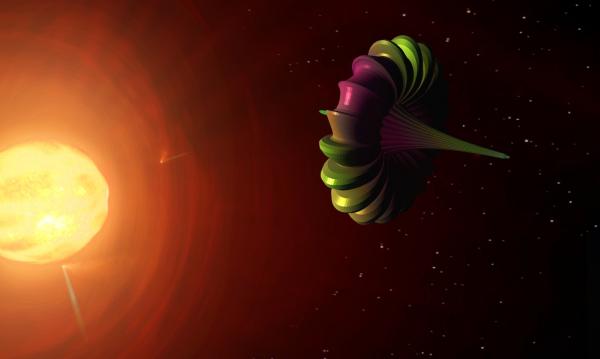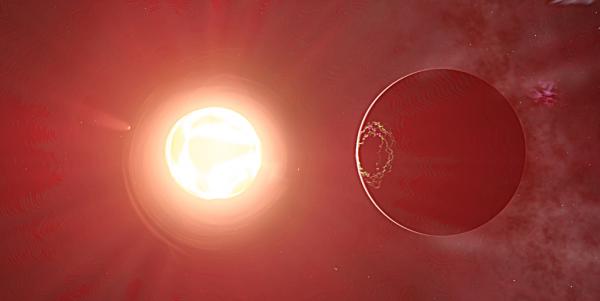BY LETTER
Gacrux and the Breather
Sophonts > Transapients > Animin
Galactography > Regions of Space > Inner Sphere
Galactography > Sephirotic Empires > Non-Coercive Zone (NoCoZo)
Galactography > Systems and Worlds > Systems & Worlds G - H
Galactography > Regions of Space > Inner Sphere
Galactography > Sephirotic Empires > Non-Coercive Zone (NoCoZo)
Galactography > Systems and Worlds > Systems & Worlds G - H
The Closest Red Giant star to Sol | |
 Image from Steve Bowers | |
| The Breather Pseudosphere is basically a sphere turned inside-out | |
System: Gacrux | |
| Star | Gamma Crucis |
|---|---|
| Type | M3.5 III red giant |
| Luminosity | 1500 x Sol |
| Distance from Sol | 88ly |
| Gal xyz | 44.31, -76.23, 8.72 |
| Planets | Gamma Crucis b (evaporating jovian) Gamma Crucis c (heated jovan) |
| Population | The Breather Pseudosphere has a population of around 160 million modosophonts, mostly nearbaseline humans and Talking Dogs; b and c together have a population of half a billion, including many space-adapted clades |
| Wormholes | Waystation Crux to Eta Crucis Shí Zì Jià to Acrux |
Gacrux is the closest red giant to Sol. This system was reached by autonomous probe in 1738 AT, but contact was lost with the probe shortly afterwards. Telescopic bservations showed that it was still active, and appeared to be engaged in construction activity of some kind. A K4H exploration-class vessel arrived in 2310, and found that the probeship AI had apparently transcended into a S:1 animin entity, which did not respond directly to their efforts to establish contact.
Orbiting the red giant is a rotating megastructure in the shape of a Breather-surface pseudosphere, 1100km in diameter and length. Contained within this structure is a toroidal habitat with rotation-induced gravity, containing an environment which the KH4 explorers found to be capable of supporting Terran life. The toroid is filled with a wide variety of entirely novel neogen plant-like and animal-like organisms, for the most part brightly-coloured and interacting in complex ecologies.
The processing matrix of the local animin is largely contained within the structure of the Pseudosphere, but it also seems to use the ecology for a significant amount of computation, and even more unusually the weather of the habitat is apparently sentient. By heating or cooling the air in the torus, adjusting the water vapour saturation, and by affecting the atmosphere mechanically with organic paddles and constrictors, the weather can be controlled with great precision. The effects of this control results in patterns of rainfall and wind that feed back into the consciousness of the animin, which the K4H explorers named Breather.
After a period of assessment, and because the Breather entity did not impede their investigations in any way, the torus was declared safe for colonisation in 2340. Many of the local plant-like and animal-like neogens were found to be edible even in a raw state, allowing the colonists to adopt a relatively lo-tech hunter-gather lifestyle. Despite this, most inhabitants of this system maintain close contact with the local and Known Nets.
These new occupants of the Pseudosphere found that the weather in the habitat displayed some curious behaviours; dust-devils and small whirlwinds were relatively common, often arranging loose dust into aesthetically pleasing patterns. Often small localised rainclouds would form over gardens or foodcrops, promoting growth; on occasion a hunter who became overheated while chasing a food animal would be cooled by a similar rainfall. Several of the animal-like creatures in this environment are quite fast runners, and it amuses the inhabitants to hunt them on foot.
In certain circumstances the weather would cause audible effects that resembled speech, or would interrupt conversations in a seemingly meaningful fashion (the wind might cause treeform branches to rattle, or whistle through foliage; even small lightning strikes sometimes appear to have meaning).
Threats in the Pseudosphere
Not every organism in the Pseudosphere is harmless, and some are actively dangerous; small (10cm) porkupines are tasty urchin-like creatures, capable of throwing sharp needles into an unwary hunter-gatherer. Gluetraps will grab a passerby and envelop them, and are very difficult to remove; the inhabitants of this world regularly develop methods of counteracting the gluetrap's adhesion, but the traps soon develop new adhesives which need to be countered. Sparkers leap onto a victim and shock them, often disabling parts of their exoself using sophisticated electric fields, usually without causing lasting harm.On rare occasions a new threat will appear in the environment, one which is both well-hidden and deadly; these threats may cause numerous fatalities before the cause is identified and neutralised, and a few threats are sufficiently sophisticated that the local population must be evacuated. Often these threats consist of extreme weather events, such as mini-tornados or lightning plagues, accompanied in some cases by pathogenic organisms. In most cases the threat will disappear after a few standard days, and the habitat becomes safe again.
However a more persistent threat emerged in the Integration (the Crying Doll), and the entire habitat was declared unsafe for several centuries. The Crying Doll was rarely seen, but often heard; it sometimes appeared in the form of a small human-like toy, often with features that resembled someone known to the witness, or the witness emself. This apparition was accompanied by heavy rainfall, mudslides and minor tremors. Remote observer drones eventually reported that these incidents were occurring less frequently, and were no longer associated with downpours or tremors, and the habitat was cautiously re-inhabited. However the population was advised to maintain detailed, and recent, backups at all times.
The Breather Pseudosphere has become a location favoured by adrenaline-junkies and thrillseekers. It is not as dangerous as certain other environments (such as the Death-Jungle of Kalii), but this environment is considered to be more unpredictable and entertaining, since the threats posed by the actions of the Breather animin are constantly changing. The Breather animin itself is considered to be a sentient but entirely strange entity, with motivations that are difficult for a modosophont to anticipate. It is not insane or malicious like a perversity or blight, but it can be terrible, like a flood, an earthquake or a drought.
Many desirable items can be found in the environment as well; powerful organic batteries,projectile weapons or explosives are not uncommon, and certain fruit will induce curious dreams that appear to be messages from the Breather itself. A number of competing belief systems have emerged among the inhabitants, each convinced they are capable of understanding the messages and the apparent language of the Breather. A small but significant fraction of the population are agnostic in this respect, and disagree with the idea that the Breather is trying to make contact in any meaningful way.
 Image from Steve Bowers | |
| Gacrux c, with Gacrux b visible in the distance | |
The Gacrux System
Gamma Crucis has two gas giants, b and c, at a distance of 3 an 7 AU respectively; they were at one time cool eujovian worlds, but since the star left the main sequence they have both heated up considerably. The outermost world has a number of former icy moons which have melted and are rapidly losing their volatiles; these have been stabilised using mirror-swarms and now support significant and diverse modosophont populations.An institute dedicated to the study of red giant stars has existed in this system since the Age of Expansion; every red giant has unique characteristics, due to the stochastic nature of their evolution. On the outer edges of the system are two wormholes, one leading to Eta Crucis and the other to Acrux and the Crucis Corridor. Gacrux is loosely associated withe the NoCoZo, but has close links with the Disarchy, which lies at the far end of their local wormhole trunkroute.
Related Articles
Appears in Topics
Development Notes
Text by Steve Bowers
Initially published on 09 January 2017.
Initially published on 09 January 2017.
Additional Information
Breather surface pseudosphere at Wikipedia






